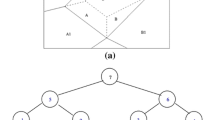Abstract
The low-temperature plastic flow of alpha-zirconium was studied by employing constantrate tensile tests and differential-stress creep experiments. The activation parameters, enthalpy and area, have been obtained as a function of stress for pure, as well as commercial zirconium. The activation area is independent of grain size and purity and falls to about 9b2 at high stresses. The deformation mechanism below about 700° K is found to be controlled by a single thermally activated process, and not a two-stage activation mechanism. Several dislocation mechanisms are examined and it is concluded that overcoming the Peierls energy humps by the formation of kink pairs in a length of dislocation is the rate-controlling mechanism. The total energy needed to nucleate a double kink is about 0.8 eV in pure zirconium and 1 eV in commercial zirconium.
Similar content being viewed by others
References
Z. S. Basinski,Phil. Mag. 4 (1959) 393.
A. Seeger, “Dislocations and Mechanical Properties of Crystals” (John Wiley: New York 1957) p. 243.
S. K. Mitra, P. W. Osborne, andJ. E. Dorn,Trans. AIME 221 (1961) 1206.
S. K. Mitra andJ. E. Dorn,ibid 226 (1963) 1015.
H. Conrad, “High Strength Materials” (John Wiley: New York, 1965) p. 436.
K. R. Evans andW. F. Flanagan,Phil. Mag. 17 (1968) 535.
H. Conrad, L. Hays, G. Schoeck, andH. Wiedersich,Acta Metallurgica 9 (1961) 367.
Z. S. Basinski,Austral. J. Phys. 13 (1960) 284.
P. Lukac,Z. Metallk. 57 (1966) 559.
D. H. Sastry, Y. V. R. K. Prasad, andK. I. Vasu,Met. Trans. 1 (1970) 1827.
P. Lukac andZ. Trojanova,Z. Metallk. 58 (1967) 57.
D. H. Sastry, Y. V. R. K. Prasad, andK. I. Vasu,Acta Metallurgica 17 (1969) 1453.
E. J. Rapperport andC. S. Hartley,Trans. AIME 218 (1960) 869.
R. W. Guard andJ. H. Keeler,Trans. ASM 49 (1957) 449.
D. H. Baldwin andR. E. Reed-Hill,Trans. AIME 242 (1968) 661.
D. G. Westlake,ibid 223 (1965) 368.
P. Soo andG. T. Higgins,Acta Metallurgica 16 (1968) 177, 187.
P. Das Gupta andV. S. Arunachalam,J. Mater. Sci. 3 (1968) 271.
D. Mills andG. B. Craig,Trans. AIME 242 (1968) 1881.
B. Ramaswami andG. B. Craig,ibid 239 (1967) 1226.
Y. V. R. K. Prasad, D. H. Sastry, andK. I. Vasu,J. Ind. Inst. Sci. 51 (1969) 377.
H. Conrad andH. Wiedersich,Acta Metallurgica08 (1960) 128.
J. C. M. Li, “Dislocation Dynamics” (McGraw-Hill: New York, 1968) p. 87.
G. B. Gibbs,Phys. Stat. Solidi 10 (1965) 507.
R. J. Arsenault,Acta Metallurica 14 (1966) 831.
N. R. Risebrough andE. Teghtsoonian,Canad. J. Phys. 45 (1967) 591.
R. L. Fleischer,Acta Metallurgica 10 (1962) 835.
Idem, J. Appl. Phys. 33 (1962) 3504.
R. L. Fleischer andW. R. Hibbard, “Relation between the Structure and Mechanical Properties of Metals” (HMSO: London, 1963) p. 261.
H. Conrad,Canad. J. Phys. 45 (1967) 581.
J. Friedel, “Dislocations” (Pergamon Press: New York and London, 1964) p. 379.
J. Friedel, “Electron Microscopy and Strength of Crystals” (John Wiley: New York and London 1963) p. 605.
P. W. Flynn, J. D. Mote, andJ. E. Dorn,Trans. AIME 221 (1961) 1148.
J. E. Dorn, “Energetics in Dislocation Mechanics” UCRL-10455, (1963).
J. E. Dorn andJ. B. Mitchell, “High Strength Materials” (John Wiley: New York and London 1965) p. 510.
A. Seeger,Phil. Mag. 1 (1956) 651.
A. Seeger, H. Donth, andF. Pfaff,Discuss. Faraday Soc. 23 (1957) 19.
J. Weertman,Phys. Rev. 101 (1956) 1429.
J. Lothe andJ. P. Hirth,Phys. Rev. 115 (1959) 543.
A. Seeger andP. Schiller,Acta Metallurgica 10 (1962) 348.
J. E. Dorn andS. Rajnak,Trans. AIME 230 (1964) 1052.
P. Guyot andJ. E. Dorn,Canad. J. Phys. 45 (1967) 983.
J. Weertman andJ. R. Weertman, “Elementary Dislocation Theory” (Macmillan: New York, 1964) p. 159.
B. Holmberg andT. Dagerhamn,Acta. Chem. Scand. 15 (1961) 919.
Author information
Authors and Affiliations
Rights and permissions
About this article
Cite this article
Sastry, D.H., Prasad, Y.V.R.K. & Vasu, K.I. An evaluation of rate-controlling obstacles for low-temperature deformation of zirconium. J Mater Sci 6, 332–341 (1971). https://doi.org/10.1007/BF02403101
Received:
Accepted:
Issue Date:
DOI: https://doi.org/10.1007/BF02403101




